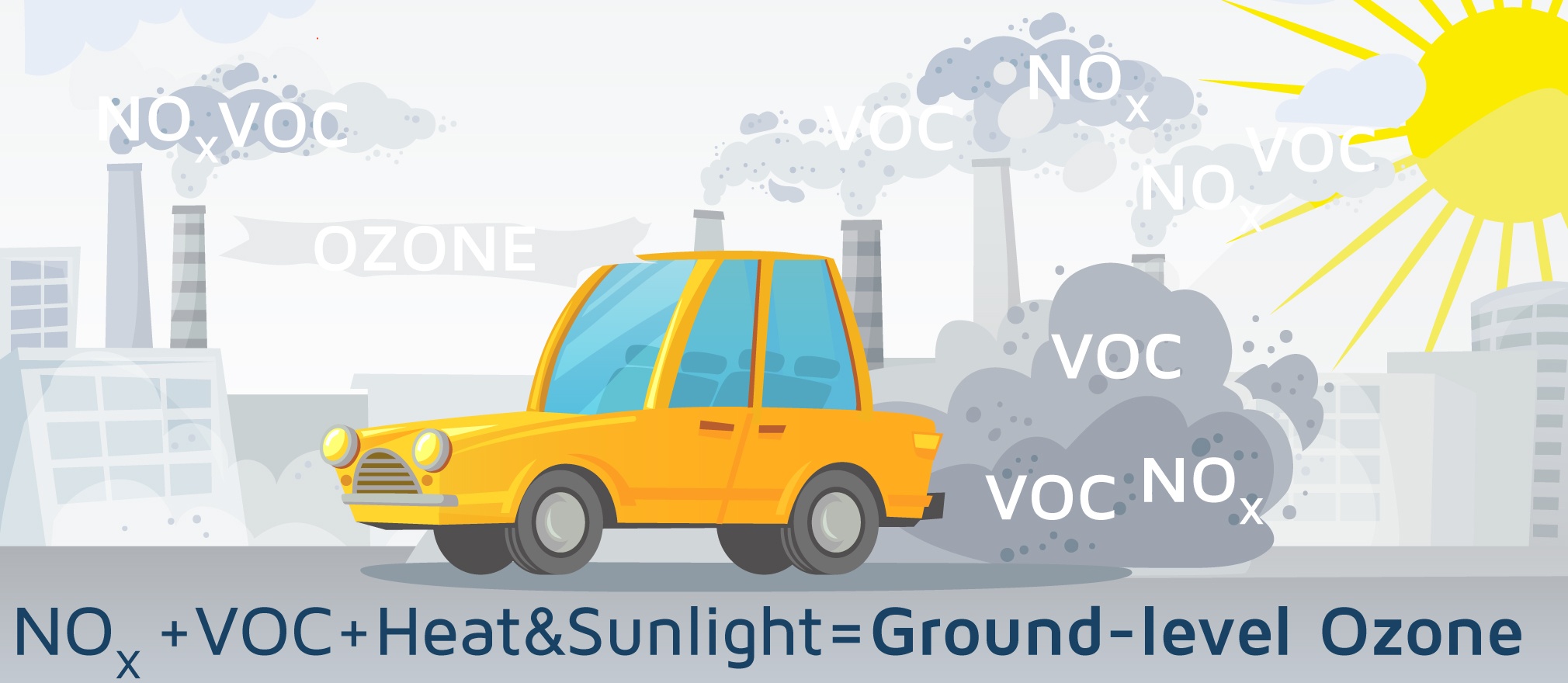Air pollution is a combination of solid particles and gases in the atmosphere that can cause serious health issues and have a negative impact on the environment. It may arise from vehicle emissions, toxins from factories, dust, and allergens. Ground-level ozone (O3) is the major contributor to urban air pollution.
What causes air pollution?
For starters, there is visible and invisible air pollution and this can be further subdivided into primary and secondary pollutants:
- Sulfur dioxide (SO2), for example, is a primary pollutant that is immediately emitted into the atmosphere.
- Secondary pollutants (smog, for instance) arise as a consequence of primary pollutants interacting with pre-existing particles in the air.
What leads to the accumulation of these contaminants in the air?
Exhaust fumes from cars -Diesel and petrol engines are the leading cause of air pollution in cities. Rapid urbanization and higher incomes lead to more cars being on the road. Since electric vehicles are not yet affordable in many countries, the demand for cheap and outdated diesel and petrol engines is on the rise. Driving those vehicles in overcrowded streets and traffic jams results in unimaginable quantities of fumes being released into the atmosphere.
Fossil fuels used by various energy-producing stations – the discharge of chemicals such as SO2 leads to acid rain when combined with water molecules.
Construction operations – ongoing digging and demolition-type construction projects release dirt and dust into the atmosphere.
Agricultural activities – ammonia is a common byproduct and a harmful chemical that is a fundamental component of ammonium nitrate fertilizer. Nearly 90% of the ammonia generated worldwide is utilized as fertilizer.
Natural origins – volcanic gases and forest fires. SO2, CO2, and hydrogen fluoride are the deadliest gases generated during an eruption.
Domestic activities – home chemicals such as bleach lead to indoor air pollution. Tobacco usage and kerosene stoves also emit hazardous chemicals into the air.
Types of air pollutants
The categorization provided by the Environmental Protection Agency (EPA):
Carbon monoxide and dioxide, particulate matter, and sulfur dioxide are probably the better-known air pollutants that can be spotted in daily news reports. This is why they are called ‘common’. However, hidden from the public are the ‘hazardous’ air pollutants that can significantly harm our health.
Here is a description of the main types of air pollutants:
- Common Air Pollutants – these are also called ‘criteria pollutants’ since they are regulated by establishing limits based on people’s health and/or environmental factors.
- Particulate matter (PM) – these occur from wildfires, volcanic eruptions, charbroiling, and vehicles. Once inhaled, they can impact the heart and lungs.
- O3 – vehicles and construction machinery generate oxides of nitrogen (NOx) and volatile organic compounds (VOC) which, together with sunlight, create O3. Once in the lungs, this can cause throat irritation and chest pain and also lead to the worsening of bronchitis and asthma.

- SO2 – from the combustion of sulfur-containing fossil fuels by locomotives and large vessels as well as from the smelting of mineral ores. Inhaling this makes breathing more difficult and it can also worsen heart and lung conditions.
- Carbon monoxide (CO) – from cars and construction gear. When inhaled, this gets into the bloodstream, lowering the body’s capacity to transport oxygen to essential organs.
- Nitrogen dioxide (NO2) – from vehicles, power stations, and off-road equipment. When inhaled, this impacts the respiratory system.
- Lead – from lead smelting, waste incinerators, and lead-acid battery producers. Even low levels of exposure to this can impact the circulatory and neurological systems.
Hazardous air pollutants
These are known to have a major impact on our health, being associated with cancer and birth abnormalities.
- Benzene (C6H6)
- Perchloroethylene (Cl2C=CCl2)
- Methylene chloride (CH2Cl2)
- Others include dioxins, asbestos, mercury, cadmium, and lead compounds.
How air pollution impacts our health and the environment
Air pollution can cause pneumonia, severe allergies, and even death. In terms of damage to the environment, it can lead to certain imbalances that contribute to global warming via the gradual thinning of the Earth’s ozone layer – a part of the stratosphere that shields Earth’s life from solar ultraviolet (UV) radiation.
Air pollution can have a negative influence depending on:
- The type of pollutant
- Time of exposure
- Intensity of exposure
- Other (such as individual health concerns and the combined effects of various pollutants)
Air pollutants’ impact on human health
Air pollution is responsible for numerous deaths among people. Tiny pollutants in the air can bypass our bodies’ defenses, impacting our respiratory and circulatory systems, causing lung cancer, strokes, and other serious health issues.
Short-term
- Pneumonia, bronchitis, and other health problems
- Nasal, throat, eye, or skin irritation
- Migraines, dizziness, and nausea
- Unpleasant odors produced by industry, waste, or sewer systems.
Long-term
- Heart-related issues
- Lung carcinoma
- Respiratory disorders such as emphysema
- Impact on the nervous system and brain
- Some scientists believe that air pollution causes birth abnormalities.
The World Health Organization regularly publishes statistics associated with the impact of air pollutants on human health and the numbers detailed by the organization in 2021 are worrying.
Air pollutants’ impact on the environment
Air pollution may harm crops or diminish their growth and it has the potential to destroy various plants including trees. This mainly occurs through acid rain which is any type of precipitation that contains acidic elements such as sulfuric or nitric acid.
Acid rain can:
- Harm plants by altering the soil structure
- Influence the water quality of lakes and rivers
- Destroy crops
- Cause a deterioration to the condition of structures
Animal health
- Animals, just like people, can be seriously impacted by air pollution which has been linked to birth abnormalities, illnesses, and lower reproductive rates.
Since air pollution is such a pervasive problem, people must join together to become part of the solution rather than continue to be part of the problem. People need to have control over how much energy they use on a daily basis and learn to reuse old materials rather than dispose of these in the environment. If we ignore what is happening, air pollution may have disastrous consequences for both our bodies and the environment.

